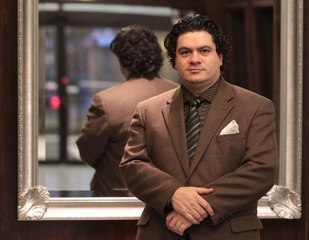|
Back
Drums Along The Hudson New York
Isaac Stern Auditorium, Carnegie Hall
02/11/2015 -
Jean Sibelius: Kuolema: Valse Triste, Opus 44 n° 1 – Violin Concerto in D minor, Opus 47
Carl Nielsen: Symphony No. 4 “The Inextinguishable”, Opus 29
Anne-Sophie Mutter (Violin)
Danish National Symphony Orchestra, Cristian Măcelaru (Conductor)

R. F. Mathiesen (© Danish National Symphony Orchestra)
While the outside world seems bent on collapsing, hope springs eternal in New York. Specifically thanks to a rebirth–and a revitalization–of Carl Nielsen. If Leonard Bernstein had been Nielsen’s “John the Baptist” 50 years ago, christening the then relatively unknown composer, the New York Philharmonic and Alan Gilbert produced a Messianic series of Nielsen’s complete symphonies last year, with as exciting performances as we thought possible.
Last night, though, the Danish National Symphony Orchestra proved a Second Coming for the great Danish Composer, and its performance of a single work, the “Inextinguishable” Symphony was filled with a grandeur, an anguish, and absolutely appropriate expansiveness.
Comparing this to Mr. Gilbert’s performance would be specious. First, because I was out of town for his performance of the Fourth. But second, not even Maestro Gilbert’s recording could ever catch the “living color” of last night’s performance. Nor would I say that the Danes had to be better since they sui generis owned the work.
More specifically, from the very first explosive beginning to the orchestral climaxes, to the “dueling kettledrums”, one heard a Nielsen that, after the aural experience, is still pounding in my mind. While the strings were overshadowed by the great brass of the Danish orchestra, that is picking hairs. The entire work, under the energetic conducting of Cristian Măcelaru, was simply glorious.
Oh, onto the kettledrums. How I wanted to run the picture above of both timpanists, René Felix Mathiesen and Lars Vestergaard Larsen, but nowhere on a frantic Google search did I find Mr. Larsen. Still, these two, with about ten kettledrums between them, gave unending virtuoso beats. True, Mr. Matthiesen had his timpani virtually to himself for most of the work, but this was far more than noise. Carl Nielsen had a soft spot (oh, sorry a fortissimo spot) for the instrument. Whether pounding on three or four drums at a time, or playing a soothing solo with pizzicato strings and duets with the rest of the orchestra, Mr. Mathiesen was at the top of his game.
The chorales for the full ensemble, the clarinet and flute solos and especially a beautiful cello solo by Henrik Dam Thomsen were marvelous. But when Mr. Larsen stood up on the opposite side of the stage, joining Mr. Mathiesen in the finale, before the greatest climax of all...
I was going to say it was paradise enow. The paradise was ruined only by knowing that Nielsen saw this work as a tragic reflection of is own agonizing life at this time. Well, biographies be damned! This was too much fun.
The Danish National Symphony Orchestra is 90 years, and in its time has been guest-conducted by every giant of the podium, from Stokowski and Bruno Walter to Eugene Ormandy and Herbert Blomstedt (whose Nielsen recordings I keep with pride). Their previous conductor was the great Rafael Frühbeck de Burgos, in whose memory the concert was dedicated.
But 90 years doesn’t begin to tell how fine Danish musicians have been. Better known for ballet than symphonies, the musicians of the Royal Danish Ballet over the past 200 years to be the finest. And when one hears the glittering brass, those fine solo winds, and the smooth strings under Mr. Măcelaru, it was evident that this has been one of the more impressive orchestras of Europe. Does it have the gravity, that dark depth of Vienna or Berlin? Or the momentous color of the London Philharmonic? Possibly not, but their own color was enough to make the second-half Nielsen unapproachable.

C. Măcelaru (© Courtesy of the Artist)
The first half was not Scandinavian at all, but devoted to Jean Sibelius. Alas, many in the audience left after the Violin Concerto, unaware of the greatness to follow.
Of course, after the Valse Triste (which sounded too much like a “Finn de Siecle” salon piece) , Anne-Sophie Mutter took to the stage with a Concerto that was of as stunning as it was predictable.
That is an unfair minimizing of Ms. Mutter and her Stradivarius and her always personal feeling for whatever she performs. From the opening here, played almost without vibrato, she broadened up to a half-hour of music ranging from the desperation to those lyrical high notes to the galloping finale. One expected nothing less from Ms. Mutter–and one was thrilled that she will be performing so many times in New York this season, from chamber recitals to the Berg Violin Concerto with the New World Symphony in April.
So, yes, Ms. Mutter was as ardent as one would want both in the Sibelius and her Bach encore. Yet thinking about this concert, one remembered above all, Messrs Mathiessen and Larson. Ms. Mutter was the Beluga caviar, upon which we could happily sup. The timpanists were simply more cosmic, more shattering, and offered more enticement for more Nielsen, and more appearances by this stunning orchestra.
One insoluble quandary. The encore, Nielsen Masquerade Overture (which I had stupidly told a friend was the “Carnival” overture), was played with equal brilliance. But the difference between this ebullient music and the deep, troubling, ecstatic Fourth Symphony was too great a chasm. My suggestion is that next time, the encore is played before the main piece.
Since that comment is illogical and inane, let’s just say that two Nielsens at a concert with Nielsen’s own orchestra, in any order, is sufficient a treasure for any evening.
Harry Rolnick
|